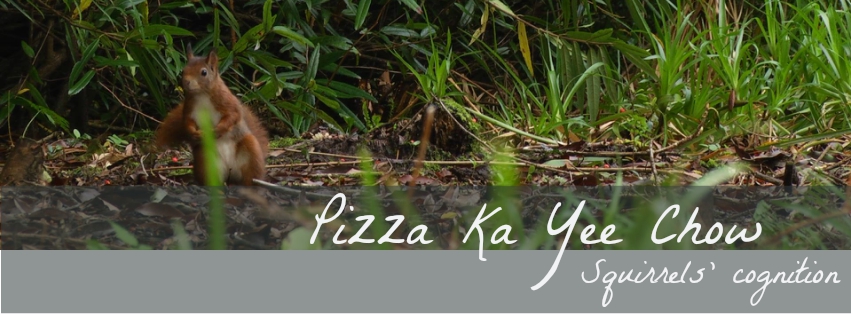A few cognitive tasks that I have established for squirrels and parrots
Novel food-extraction task 1 – Hinged box (Easy task)

I call this food-extraction task as ‘the hinged box’ task. It has 16 containers that each covered by a lid. You will see a reward (a hazelnut) is placed in the container and that is covered by a transparent lid. To solve the problem, squirrels have to use their teeth, nose or front paws to lift up a transparent lid and obtain a nut. Squirrels solved this task easy-peasily, and therefore it is considered as ‘Easy’ for them.
Novel food-extraction task 2 – Puzzle box (Difficult task)

I call this food-extraction task as ‘the puzzle box’. This food-extraction apparatus has 10 levers. 5 of these levers contained a reward (hazelnut) and the other 5 levers are empty (control). As you can see, the nuts are placed just inside either end of the box, making them out-of-reach to squirrels/parrots. To solve the task, squirrels/parrots have to pull a lever end if they are far away from the nut container, or push the lever end if they are close to the nut container. That is to say, the successful solutions of the problem are counterintuitive. Squirrels generally took more time to solve this task than the easy task (above), and therefore it is considered as ‘Difficult’ for them.
*** I also used this box to test squirrels’ memory. To do this, I presented the same box to squirrels in the lab (around) 2 years after they had seen the box as well as squirrels in the wild 25 days after their last experience with the box.
Generalisation box

When squirrels have mastered one of the successful solutions (push-in the lever in most if not all cases) for the original puzzle box, this generalisation box assesses whether squirrels would be able to apply the successful learned solution to solve a similar but different problem. Noted that squirrels took longer to approach this new box than the original box, indicating that they noticed a difference. Also noted that the colour of the levers were changed to different colours (i.e., not white) in subsequent experiments so as to increase the difference between the original and the generalisation box.
A modified food-extraction task

Squirrels gradually master one of the successful solutions, push-in a lever, when solving the puzzle box. Here is a modified food-extraction to assess whether the squirrels would be able to inhibit this learned behaviour, and use alternative methods (i.e., pull out a lever) to solve the task.
Spatial learning task

This is a spatial learning task that I have developed for squirrels. It is modified from the hinged box task (Easy task). You can see that the 16 containers are now organised as 4 ‘corners’. In each container, there are 5 small holes at the bottom of it. More to this is that, I added another layer below the apparatus – the base . The base of the apparatus is filled with inaccessible hazelnuts pieces; this allows the scent of hazelnuts filled with rewarded and unrewarded containers, and thus control squirrels using olfactory cues during the task. In this task, the rewarded containers are baited diagonally. To solve the problem, squirrels have remember where the nuts are. Once they have located a container, they can use their teeth, nose or front paws to lift up a transparent lid and obtain a nut.

